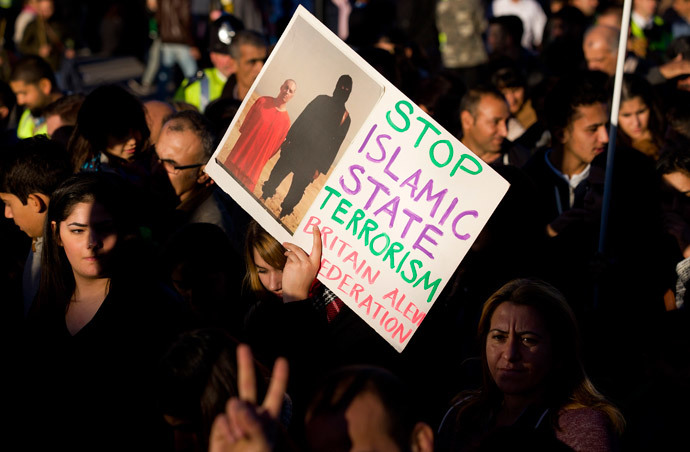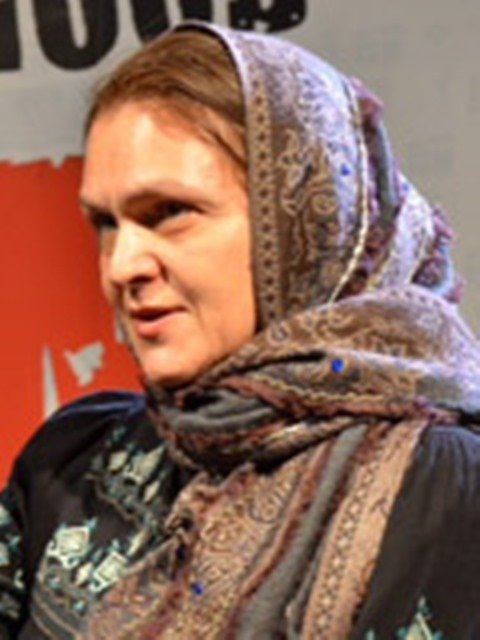Why do we know nothing about ISIS?

“Don’t you know that Isis was the name of an Egyptian goddess?” a colleague from Iraq recently wrote me. “Mind you, they never give things names for no reason in the West. Terror, death and fear – that is what we have to cope with day by day.”
Indeed, no one in the West refers to ISIS by its original Arabic name, Daesh. Even after the organization once known as ISIS/ISIL restyled itself as the Islamic State, it still largely goes by its former name in the Western media.
Where dog-headed people live
“He speaks also of another race of men, who are known as Monocoli, who have only one leg, but are able to leap with surprising agility. The same people are also called Sciapodae, because they are in the habit of lying on their backs, during the time of the extreme heat, and protect themselves from the sun by the shade of their feet. They live not far from the Troglodytae. There are also tribes of dog-headed people, who live in the mountains, wear skins of wild animals, and speak a language that sounds like barking. They hunt animals and birds for food, to which end they use their own fingernails for a weapon.”
This is how Pliny the Elder, a 1st Century Roman military commander, naturalist and writer described obscure tribes presumed to inhabit distant lands to the north of what was considered civilization at the time. Pliny supported such ethnographic fantasizing by citing numerous Roman and Greek travelers, officials and historians (including Herodotus) who had supposedly seen those strange people with their own eyes.
It would seem that knowledge and information gathering have come a long way by the 21st Century, with its sophisticated technology and advanced media. But that’s nothing but wishful thinking. Try to find any reliable information on the Islamic State these days, and you end up reading the same clueless accounts of “dog-headed people” all over again.

ISIS and the Plinys of today
Just like Pliny’s fictional tribes, ISIS is wrapped in myth and speculation. Few people have any first-hand knowledge of the organization, and yet the entire world is talking of it as the number one threat.
Media research on ISIS will definitely leave you with plenty of videos, maps, and seemingly accurate bios of the organization’s key figures. And unless you are an old hand in assessing the credibility of media reports, you might take all those accounts at face value – just like Pliny’s contemporary readers used to.
Let’s look at a map of the Middle East. Until very recently, almost half of it was painted red in Western maps, marking ISIS-controlled territory. Then, all of a sudden, this menacing colossus stumbles upon a militia formed by 30-odd Kurdish villages in North-Western Syria, and within days, the vast red splotch on the map shrinks by one-third. The supposedly formidable “jihadists” have suffered a crushing blow from a bunch of villagers.
Meanwhile, the world’s mightiest military power spends several months gearing up to take on ISIS, hammering together a coalition, and issuing pledges by President Obama to fight to the end. The first US air strike against ISIS kills eight civilians, three of them children. Over the next two months, the coalition delivered more than 200 air strikes in Iraqi territory, and another sixty in Syria. Despite all that firepower and state-of-the-art technology, the red patch on the map remains unchanged. The elusive “jihadists” seem to be little impressed by the allied war effort.
So what the media are trying to tell us, essentially, is that, after beating the war drum and leading the world to speculate about a ground operation for two months, the US military has been unable to inflict any more damage on its number one enemy than a bunch of Kurdish irregulars?
The US military is bombing targets in Iraq and Syria, and no one is keeping the body count. There is statistics listed at Iraq Body Count, but it does not reveal how many of the overall casualties in Iraq were killed by US air strikes. In fact, that website relies on data collected by the United States. It was originally created to cover up for all the killing done in Iraq by the US-led occupation force following the 2003 invasion. Today, with ISIS being cast as the new arch-villain, that website seems to have come in handy again.
We don’t know how many casualties come from the new US-led bombing campaign, and who those people actually were. And we still don’t know who forms ISIS. In fact, we can’t even say with any confidence how many they are: media estimates of the Islamic State’s strength vary from 17,000 militants to 80,000 to 250,000. The same goes for the stats on ISIS victims, as claims are often made with no evidence cited.
Why there are no reports on ISIS
The lack of knowledge is due an obvious reason. Even before, journalists were not too eager to go to ISIS, and now, after the beheading videos, nobody wants to work with them.
So, what do we know – or at least think that we know – about ISIS?
Many people have forgotten this, but experts will remember that ISIS was initially identified as a group that started an internal conflict among anti-Assad rebels in the summer of 2013. Rebels were popular in the West. Many journalists worked with them. So, we are told that the rebels were defeated because of ISIS: instead of fighting government forces, ISIS fought against other groups. Apparently, ISIS never even engaged Assad troops.
However, people forget that it was ISIS who released prisoners, for example, from the notorious Abu Ghraib prison in the summer of 2013. Many of the current IS commanders and ideologists are former Abu Ghraib inmates who took part in the Fallujah uprising against US occupation and were imprisoned and tortured after the rebellion was crushed. Others used to be officers in Saddam Hussein’s army and also went through torture.
Why are there no interviews with these people?
Several execution videos were circulated on behalf of ISIS in the last couple of months. Those killed include journalists Jim Foley and Steven Sotloff who sympathized with the rebels, aid worker David Haines and altruistic taxi driver Alan Henning who delivered food to rebels, and just a French tourist who went to Algeria on his friends’ invitation.
It’s as if somebody was saying on behalf of ISIS: we don’t need journalists, we don’t need aid workers.
This is very strange. This is not how the rebels usually treat the media. Last century, they took good care of correspondents who sympathized with them and would never stage a series of executions.
Could it be that things are not what they seem? After all, it was the US that set the record of “working” with the press in Iraq, killing over 370 correspondents during the occupation. Of course, they never slit their throats but they would shoot a journalist, sometimes from close range, clearly seeing that they had nothing in their hands except a camera. In fact, the US invasion in Iraq started with an airstrike on the Palestine Hotel in Baghdad where all the international correspondents were staying.
It is amazing that instead of treating journalists the same way rebels do, ISIS fighters for some reason imitate Americans. Or do they?
Earlier in October, one ISIS territorial subdivisions released a code of conduct for journalists. Essentially, it demands that journalists must get accreditation and remain neutral. Muslim journalists are required to promise they will remain neutral. Western media misinterpreted the requirement, claiming that journalists are forced to take the oath of allegiance and can’t report freely, that their material needed to be approved by ISIS. But a certain degree of cooperation is always expected of a journalist working in a warzone. The whole world saw Jane Fonda’s picture on a tank with the North Vietnamese flag. I don’t think she would be allowed to pose with that flag in Saigon.
Interestingly, IS allows reporting on social media but has banned Al Jazeera, Al Arabiya and Orient. That’s because the first is the mouthpiece of the Muslim Brotherhood; the second, the mouthpiece of Saudi Arabia; and the third, the mouthpiece of Syria. But, on the other hand, Western countries also stop Palestinian, Lebanese and Iranian channels from working in their territory – even at the time of peace.
So, what does this code mean? Have ISIS fighters realized that they need journalists? Or is it just that they have finally been able to break through all the lies and reach out to the media?
I, for one, would be willing to get accredited and go there.

Japanese journalist: ISIS is not like that
There is one journalist in the public space who had stayed with ISIS for 18 days and returned safe and sound. But he was unable to film them for more than 20 minutes.
Shamil Tsuneoka, a Japanese national converted to Islam, traveled to Syria to visit his friends.
He went there twice, in April and October 2013, which was before and right in the middle of ISIS confrontation with other jihadist groups.
The few things that Tsuneoka does say about ISIS contradict its image portrayed by the media. He stresses that ISIS does not launch attacks on target civilians.
The journalist says when he talked to the ISIS leaders they did not express any animosity toward the West. He does bring up their hateful words regarding Assad and the Shiites.
He doesn’t fail to mention that the Free Syrian Army members fighting against Assad had told him that ISIS were “insane, dangerous enemies, and he was in a serious conflict with them.” At the same time, one of the ISIS commanders who originally come from Syria showed his photos together with FSA commanders.
Tsuneoka believes that Syrians of various rebel groups keep friendly ties with each other despite the difference of opinions, but they are all cautious about foreign fighters.
He explains that IS has a solid base among the locals. For instance, one of the commanders he knows used to be a priest at a mosque, and has a good standing with the local residents.
The journalist refutes the reports by the Western media that ISIS makes women cover their faces. “I don’t think anyone’s forcing them to wear niqabs.” He refrains from bringing up such issues as mass trafficking in women, sexual jihad, and other media spooks.
Tsuneoka emphasizes that ISIS sets up numerous checkpoints, and doesn't let through foreigners such as doctors, humanitarian workers, or journalists.
He also notes that ISIS is obsessed with spies. If they think a captive is an Assad supporter they would execute him immediately. He insists that ISIS executed approximately 40 militants on the assumption that they were Turkish or Saudi Arabian spies.
Basically one can conclude from his story that we aren't dealing with dog-headed people. He is telling a story of ordinary insurgents in an invaded, war-torn country.
ISIS through the eyes of an anonymous Kurd
Here’s a different way of telling a story. A Kurdish IS member introduced himself under the fake name of Sherko Omer. He surrendered to the pro-Kurdish People’s Protection Units. He shared his story with a journalist who was expecting him to confirm the atrocities.
One would expect only negative stories and exposures from such a narrator. However you get a really interesting picture once you ignore the journalist’s bias.
Together with his friends he left Iraqi Kurdistan to join a training camp in Turkey. Initially he intended joining FSA but ended up with ISIS. The people who recruited them had no beards, dressed in modern clothes and, according to him, looked like FSA members. He noted that IS commanders were very nice and respectful at the camp. They gave trainees the best food, clothes, and weapons, and “we enjoyed the friendship and brotherhood.”
Sherko Omer stressed that although the ISIS political leaders are portrayed as thugs in reality they pay attention to education, and educated recruits.
Omer was a technician, and his skills were made use of there.
At the same time, he noticed that there were uneducated people among the rebels. Those were usually sent to fight at the frontline. Just like in any war, they were mainly responsible for the atrocities.
He described witnessing an incident in Al-Raqqa where six militants demanded that a Christian woman and her 13 year old daughter became their wives. He explained that he had protested against treating women that way, and that he went to the local court trying to prove that it was forbidden in Islam. But the judge accused him of having poor faith, and his field commander had to save him.
Omer decided to leave ISIS when he witnessed a wounded captured Kurdish YPG fighter publically executed. Omer was amazed by his extreme bravery. His fingers were cut yet he shouted insults against the jihadists. He was finally beheaded from behind to suffer and salt was put on his half-cult neck to die in agony.
His commander explained that the IS should first fight impure the Muslims of Palestine and Kosovo to purify them and this way Israelis and Serbs would not exist.
This part of the interview reminded me of something FSA fighters told me in the Turkish hospital. They also believed in the same sequence of doing justice: purify your own people to scare others.

Executions
The video of mass executions in Tikrit, commented on by a former Iraqi soldier, provides strong evidence of IS’ horrible crimes.
But as you’re watching the video, a number of questions may arise. First of all, how come journalists were able to film the soldier in his home, but failed to find people who would provide video footage of the burial sites? Why didn’t anyone try to ask ISIS commanders for an explanation? And finally, why didn’t anyone talk to the local people?
Why has the number of those executed soared from 160 to 1,700? And I would also like to know who was filming this video so diligently?
Witnesses add to controversy
My sources in the region had a chance to contact people who have escaped from the IS controlled areas. Their story is different from the one presented by the media.
First, they say that despite the reported mass executions IS does not hurt engineers, electricians, doctors, utility workers, postmen and other specialists. In Raqqa, they have kept the dam employees and traffic police in place. Most of these specialists are not religious and some of them are not Sunni. The IS commanders are inviting professionals from all over the world to come and help. According to my sources, telecommunication systems were installed by an engineer from Tunisia. There are also some doctors from China and engineers from Algeria, Egypt and Jordan.
Some villages still have their mayors and government officials, roads are still being maintained and public transport still runs.
The Ikhwan, or the Muslim Brotherhood, is an organization which was established after WW1 for Muslims to support one another. They built hospitals, schools, kindergartens, foundations to support talented children from poor families. After WWII the organization became prevalent in Arab countries. The Ikhwan experienced a revival after the Islamic revolution in Iran. Then its experience was used to establish social institutions. In the 1990s the Ikhwan leaders urged their followers to participate in local parliamentary and municipal elections. The Palestinian Hamas and the Lebanese Hezbollah are closely following the Ikhwan principles, which explains why so many people support them. The Wahhabis- Salafis deny that the Ikhwan participated in elections.
IS established Sharia courts in all the territories they hold – there are no robberies, thefts, acts of violence or taking over of property in these territories. Islamic tax is lower than government tax. The Islamic administration pays monthly salaries – $400-600, which is about what people get in Damascus and Baghdad. Widows are paid $100 plus $100 for each child. The houses of officials who have run away are given to the poor and to the militants. ISIS supports small businesses – auto repair shops, appliance repair shops, computer firms and basic goods producers. IS provides businessmen with work space, grants them small subsidies and provides them with security guards and cargo escorting.
According to my sources, the distribution of food among the poor is under control. The rich pay a special tax to support the poor.
There’s also what you may call a cultural life: in Mosul, they held the Koran recital competition and even a football match.
And though the IS is hostile towards the Muslim Brotherhood and the Shias, it’s the Ikhwan and Hezbollah that are closely following the fundamental principles of Islam. So some of IS members are experts in this field.
Finally, IS cooperates with the Naqshbandi Army made up of powerful Sufi sheikhs and former officers of Saddam Hussein’s army who have been resisting the occupation forces for a decade. Naqshbandi is a major Sufi order, founded in the 14th century and prevalent in many regions from Turkey and the North Caucasus to Central Asia and India. The Sufi order has its headquarters in Mecca and London and has strong ties with global elites.
The question concerning the intolerance of IS ultra-fundamentalists and sectarians remains unresolved. So is the question whether monopods protect themselves from the sun by the shade of their only foot.
The statements, views and opinions expressed in this column are solely those of the author and do not necessarily represent those of RT.
The statements, views and opinions expressed in this column are solely those of the author and do not necessarily represent those of RT.













